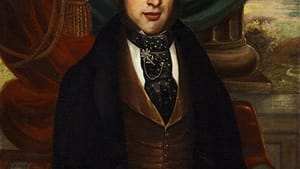Stay in the Loop
BSR publishes on a weekly schedule, with an email newsletter every Wednesday and Thursday morning. There’s no paywall, and subscribing is always free.
Catch the premiere of a film spotlighting the Montiers of Philadelphia

The Philadelphia area was home to a historic free black community whose local roots predate the Revolutionary War, and a new documentary is finally giving us a glimpse of its descendants. You can catch the premiere of The Montiers: An American Story on Wednesday, March 14, at the Philadelphia Museum of Art, along with an extraordinary pair of portraits, and a panel of special guests that Philly art, history, and genealogy enthusiasts will not want to miss.
The mayor’s descendants
In 1691, Humphrey Morrey (c. 1650-1716) became Philly’s very first mayor, appointed under William Penn’s original charter incorporating Philadelphia as a city. Morrey, who was born in England, worked as a merchant and then a justice of the peace in Philadelphia in the 1680s. He served a 10-year term as mayor and was one of the 15 founders of Cheltenham Township — in 1683, he received a 250-acre land grant from Penn himself.
Here, we can begin tracing the story of the Montiers as we know them. Humphrey Morrey was a Quaker slaveowner. After his son Richard inherited his property, Richard Morrey became one of the first Americans to free his enslaved people (in the early to mid-1700s). Some formerly enslaved workers stayed on in the family’s employ, including a servant woman named Cremona. Morrey was married, but around 1735, he began a relationship with Cremona.
Cremona and Morrey had five children together and Cremona took Morrey’s name. He also gifted her 198 acres of land in what is now Cheltenham, an extraordinary holding for a black woman at the time. That land became a community known as Guineatown, which housed about 20 free black families by the time of the Revolutionary War. Cremona’s youngest daughter by Morrey (after his death, she married and continued her family), also named Cremona, was born around 1745.
The Montiers
The younger Cremona married John Montier (who may have arrived in the American colonies from Haiti) in 1766. One of her sons, Solomon Montier, became a shoemaker in Guineatown and later Philadelphia. Solomon and his wife had four sons, including Hiram. Hiram Montier continued his father’s trade at a shop on 7th Street (near Independence Hall) and was also a cofounder of Bethel African Methodist Episcopal Church of Germantown. He died in Germantown in 1861 and was buried in Cheltenham, in the cemetery of the original Montier family estate on what had been Guineatown. (If you want to learn more, read “The Montiers: An American Family’s Triumphant Odyssey,” by Donald Scott, for the online AfriGeneas Library.)

Here’s where the art lovers should listen up. When Hiram Montier married Elizabeth Brown in 1841, the young African-American couple made the rare and costly decision to commission a pair of lavish portraits, celebrating their family’s important status in Philly through the 18th and 19th centuries. Painted by Philadelphia artist Franklin R. Street, the works are now our oldest surviving portraits of an African-American couple. They offer an important window on family life for free African-Americans in 19th-century Philadelphia.
Meeting the Montiers today
The Guineatown cemetery is lost (the bodies were apparently relocated after a 1963 road-widening project, though researchers don’t know where they ended up), but you can see the paintings of Hiram and Elizabeth Montiers at the Philadelphia Museum of Art, on loan from the Collection of Mr. and Mrs. Pickens III since 2009.
Now, the documentaryThe Montiers: An American Story will get its premiere during the PMA’s Wednesday evening pay-what-you-wish hours on March 14. The screening is free after admission and seating is first come, first served. An audience Q&A will follow, featuring WHYY’s Karen Smyles (the film’s producer); Philly native Deesha Dyer, the Obamas’ White House social secretary; Dr. Gwendolyn DuBois Shaw of the art history department at the University of Pennsylvania; and William Pickens III, a direct descendant of Hiram Montiers. According to hosting partner WHYY, the conversation will focus “on the importance of these portraits as works of art and a source of pride for a younger generation of African Americans.”
The documentary will air on WHYY-TV on Friday, March 16, at 8:30pm.
The Montiers: An American Story screens at the Philadelphia Museum of Art on Wednesday, March 14, at 6:30pm, followed by a panel discussion. Admission is pay what you wish.
Above: William Pickens III and his wife, Patricia, at the Philadelphia Museum of Art in 2010, in front of the 1841 portraits of Hiram and Elizabeth Montier. (Photo courtesy of the Philadelphia Museum of Art.)
Sign up for our newsletter
All of the week's new articles, all in one place. Sign up for the free weekly BSR newsletters, and don't miss a conversation.
 Alaina Johns
Alaina Johns